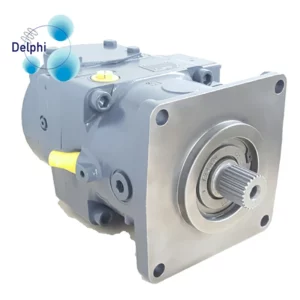An axial piston variable pump is a type of hydraulic pump that is commonly used in industrial and mobile applications, such as construction equipment, mining machinery, and agricultural machinery. It is designed to generate fluid flow and pressure in a hydraulic system, which is then used to power hydraulic motors, cylinders, and other hydraulic components.
The axial piston variable pump consists of a series of pistons that are arranged in a circular pattern around a central shaft. The pistons are housed in a cylinder block and are connected to a swashplate, which is mounted on the central shaft. The swashplate can be rotated to change the angle of the pistons, which alters the volume of fluid displaced by the pistons, and thus the flow rate and pressure of the hydraulic fluid.
The axial piston variable pump is capable of providing a wide range of flow rates and pressures, and is known for its efficiency and reliability. It is often used in applications that require precise control over fluid flow and pressure, such as in high-pressure hydraulic systems for heavy machinery.
Proper use and maintenance of axial piston variable pumps is essential for safe and reliable operation. It is important to follow the manufacturer’s recommendations for use, including the fluid type and quality, pressure rating, and recommended use, and to avoid overloading or exceeding the weight capacity of the pump. Additionally, it is recommended to use safety equipment, such as safety stands or chocks, to prevent injury or damage in the event of an accident.
Regular inspection and maintenance ofthe hydraulic system, including the axial piston variable pump, hoses, and fittings, can help prevent wear and tear and address any issues promptly. During the inspection, a qualified mechanic will check the pump for any signs of wear, damage, or leaks, and will also check the fluid level and quality. They will also check the hydraulic system for any signs of contamination or overheating.
If you suspect that your axial piston variable pump is not functioning properly, it is recommended to have it inspected and repaired by a qualified mechanic to ensure safe and reliable operation. It is important to address any issues with the hydraulic system promptly, as they can affect the performance and safety of your equipment and lead to more expensive repairs down the line.
Proper use and maintenance of hydraulic pumps and systems can help ensure safe and reliable operation, as well as extend the lifespan of the equipment. It is recommended to follow the manufacturer’s recommendations for use and maintenance, including using the right type and quality of hydraulic fluid, axial piston variable pump avoiding overloading or exceeding the weight capacity of the pump, and inspecting the hydraulic system regularly for signs of wear, damage, or leaks.
Additionally, it is recommended to use safety equipment, such as safety stands or chocks, to prevent injury or damage in the event of an accident, and to follow proper operating procedures to avoid unnecessary wear and tear on the hydraulic pump and other components.
Proper maintenance of hydraulic systems is essential to ensure safe and reliable operation, as well as to extend the lifespan of the equipment. Some best practices for maintaining hydraulic systems include:
Follow the manufacturer’s recommendations: It is important to follow the manufacturer’s recommendations for use and maintenance, including the type and quality of hydraulic fluid, pressure rating, and recommended use. This will help ensure that the system operates properly and will help prevent unnecessary wear and tear on the components.
Regular inspection: Regular inspection of the hydraulic system, including the pump, hoses, and fittings, can help prevent wear and tear and address any issues promptly. During the inspection, a qualified mechanic will check the system for any signs of wear, damage, or leaks, and will also check the fluid level and quality.
Use the right hydraulic fluid: Using the right type and quality of hydraulic fluid is essential to ensure proper operation and to prevent wear and tear on the components. It is important to use the hydraulic fluid recommended by the manufacturer and to follow the recommended change intervals.
Avoid overloading or exceeding weight capacity: Overloading or exceeding the weight capacity of the hydraulic system can cause damage to the components and can lead to reduced performance and efficiency. It is important to follow the weight capacity recommendations for the equipment and to avoid overloading or exceeding the weight capacity.
Follow proper operating procedures: Following proper operating procedures can help prevent unnecessary wear and tear on the hydraulic system and components. This includes avoiding suddenstarts and stops, avoiding excessive heat or cold, and avoiding harsh driving conditions.
Keep the system clean: Keeping the hydraulic system clean and free from debris, dirt, or other foreign materials can help prevent contamination and damage to the components. Regular cleaning of the equipment and surrounding area can help prevent contamination and reduce the risk of damage.
Use safety equipment: Using safety equipment, such as safety stands or chocks, can help prevent injury or damage in the event of an accident or malfunction. It is important to follow proper safety procedures and to use safety equipment as recommended by the manufacturer.
Address issues promptly: If you notice any signs of wear or damage in the hydraulic system, it is important to address them promptly to prevent further damage or failure. Regular inspections and maintenance can help identify issues early and prevent more expensive repairs down the line.
Proper use and maintenance of hydraulic systems can help ensure safe and reliable operation, as well as extend the lifespan of the equipment. It is recommended to consult a qualified mechanic or technician for assistance with installation, repair, or maintenance of hydraulic systems, and to follow the manufacturer’s recommendations for use and maintenance.
